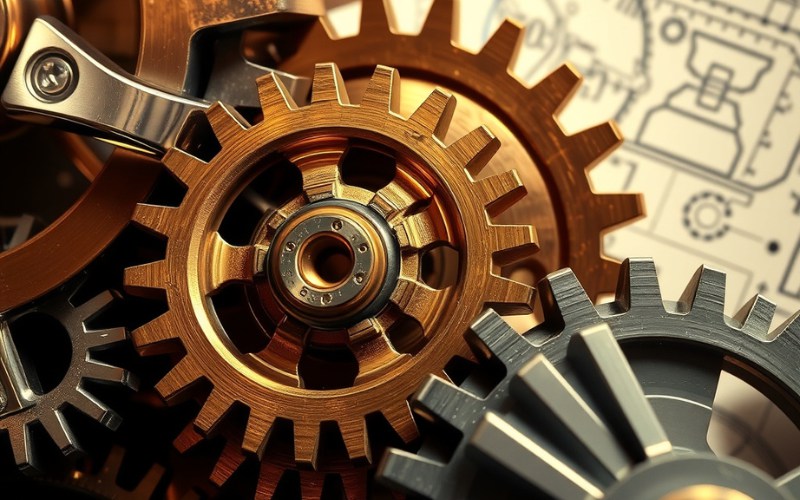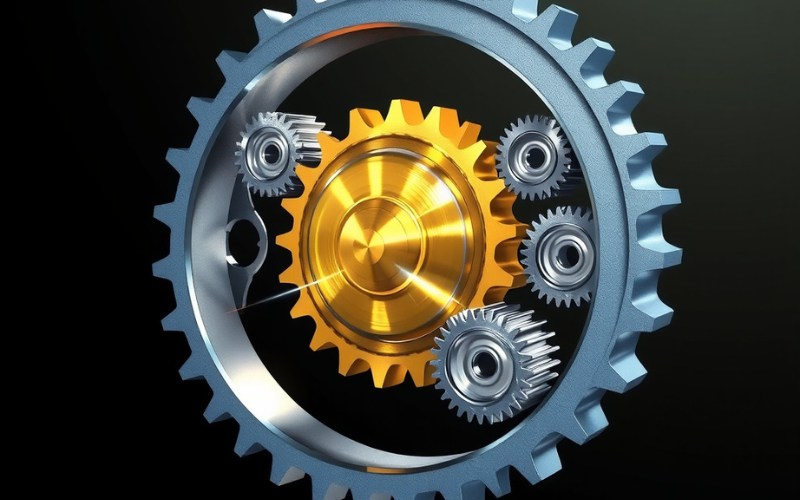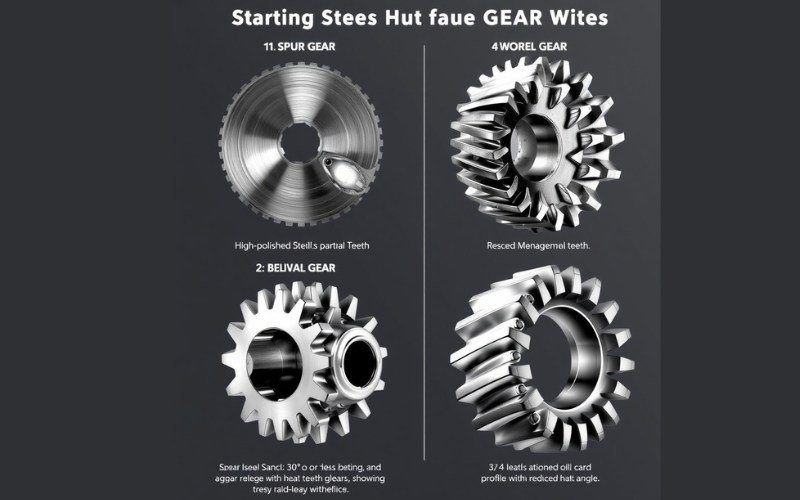دع Istar يساعدك على البدء في مشروعك من خلال خبرتنا ودرايتنا!
قم بتحميل ملفات التصميم ومتطلبات الإنتاج الخاصة بك وسنعاود الاتصال بك في غضون 30 دقيقة!

A gear is a simple wheel that has teeth on it. It is a very important part in a lot of machines. This article is my simple explanation of the different types of gears. We will look at what makes each gear special. If you want to know how machines move, this article is a good read for you.
Let me tell you about the type of gear you see most often. It is the spur gear. A spur gear is a simple, round gear. Its teeth are straight. They also run in the same direction as the gear’s shaft. When you picture a gear in your mind, you are probably thinking of a spur gear. Spur gears are one of the most basic gears used. I see them all the time because they are easy to make. They also work very well. A spur gear is a wonderful choice for many simple machines. This gear is not hard to design.
When two spur gears connect, they move power from one shaft to another shaft. These gears are used with parallel shafts. This means the two shafts that the gears are on are next to each other. They point in the same direction. A spur gear train is made of two or more of these gears working as a team. Because the teeth are straight, they make a clicking noise when they touch. This can be loud, especially when they move at high speeds. The spur gear is a gear that does a lot of hard work. It is not fancy, but this gear always gets the job done. It is a very important gear.
Now, let’s talk about a gear I think is very smart: helical gears. Helical gears are a lot like a spur gear, but they have a twist. It is a real twist. The teeth on helical gears are cut at an angle to the gear’s shaft. This small change makes a very big difference. With spur gears, the teeth hit all at once. Helical gears are different. Their teeth connect slowly. One end of the tooth touches first. Then, as the gear turns, the connection moves along the tooth. This makes helical gears run much smoother. They are also quieter than spur gears.
This smooth action lets helical gears operate at high speeds with less noise. Because of this, helical gears are used a lot in car transmissions. But, the angle on the teeth of helical gears makes a force called thrust. This is a push to the side on the gear and its shaft. To deal with this push, machines with helical gears often need special parts called thrust bearings. There is also a double helical gear, which is often called a herringbone gear. A herringbone gear has two sets of teeth that are angled in opposite ways. This special gear stops the thrust force. Single helical gears are seen more often. Helical gears are great for moving a lot of torque without a lot of noise. This gear is a quiet and strong gear.

Sometimes, you need to make power change direction. For instance, you may have a spinning shaft that needs to turn another shaft at a right angle. This is a job for a bevel gear. I have used a bevel gear in many projects where power needed to turn a corner. Bevel gears have a cone shape. Their teeth can be straight, or they can be curved. Bevel gears are used to send power between two shafts that cross over each other.
The most common way a bevel gear is used is to connect shafts at a 90-degree angle. Think about a hand drill. A small gear turns a bigger gear, which makes the drill bit spin. That is often a pair of bevel gears doing the work. The smaller gear is often called a pinion. A bevel gear is a very helpful gear. There are a few different types of this gear. The most simple type is the straight bevel gear. It has straight teeth, just like a spur gear. This type of bevel gear is simple, but it can be a little loud. The bevel gear is a key gear for making motion change direction.
When I need a bevel gear for a job that is fast or needs to be quiet, I always pick a spiral bevel gear. A spiral bevel gear is a type of bevel gear that has curved teeth. This is like how helical gears have teeth at an angle. The curve on the gear teeth of a spiral bevel gear lets them connect more slowly, a little at a time. This means they run smoother. They are also much quieter than a straight bevel gear. Spiral bevel gears are bevel gears with teeth that look like they are winding.
The spiral bevel gear is very strong. The curved teeth have more of their surface touching the other gear at all times. This spreads out the force. It lets the gear manage more torque. You can find a spiral bevel gear in many machines that do heavy work. Zerol bevel gears are a special kind with a zero spiral angle. There are also hypoid gears. A hypoid gear is like a spiral bevel gear, but the shafts do not cross. One shaft is higher than the other. This lets the shaft go past the gear. You see hypoid bevel gears in the back axles of many cars. A spiral bevel is a very good gear.
Here is a simple table to show the difference between these two types of gear:
| الميزة | Straight Bevel Gear | Spiral Bevel Gear |
|---|---|---|
| Tooth Shape | مستقيم | Curved (Spiral) |
| Noise Level | Loud | Quieter |
| السرعة | Good for low speeds | Good for high speeds |
| القوة | جيد | رائع |
| الاستخدام الشائع | الآلات البسيطة | Car axles, heavy machines |
The worm gear is one of the most interesting kinds of gear I have worked with. A worm gear set comes in two parts. The first part is the worm. It looks like a screw. The second part is the worm wheel. This is a gear that looks like a spur gear or a helical gear. The worm and the gear connect together. The worm gear is special because it can slow things down a lot in a small amount of space. For each full turn of the worm, the gear moves just one tooth. This means you can get speed changes of 20 to 1 or even 300 to 1 with just one worm gear set.
Another special thing about a worm gear is that it is usually self-locking. This means the gear cannot make the worm turn. Power can only move from the worm to the gear. I used a worm gear to build a winch one time. The self-locking part was great for safety. When the motor stopped, the worm gear kept the heavy item from falling. This gear type makes a lot of rubbing, which means it can get warm. The sliding contact of the gear surfaces needs to have good oil on it. A worm gear is a wonderful gear for high torque and low speed. This gear is very strong.
Have you ever thought about how a car’s steering wheel is able to turn the car’s wheels? The answer is often a rack and pinion system. This is a special gear drive. It changes turning motion into straight-line motion. The rack and pinion system has two parts. The pinion is a normal round gear, usually a spur gear. The rack, or gear rack, is a straight bar with teeth cut on it. It is like a gear was unrolled and made flat.
When you turn the pinion gear, its teeth connect with the gear rack. This pushes the gear rack from side to side. In a car, the steering wheel turns a shaft that has a pinion gear on the end. The pinion moves the gear rack. The gear rack is connected to the car’s wheels, so this makes them turn left or right. A rack and pinion gear is a simple and direct way to get this type of movement. I have also seen a gear rack used in machines like drill presses. It moves the main part up and down. It is a very smart use of a gear. The contact of the gear surfaces is very simple. This is a simple gear.
Most gears that you see have teeth on the outside of a wheel. But what if the teeth were on the inside? That is exactly what an internal gear is. An internal gear is a ring. It has teeth cut on the inside surface. It connects with a normal outside gear, or pinion. The pinion fits inside the internal gear. This is a gear setup that takes up very little space. It is very useful when you do not have much room.
One of the neat things about an internal gear is that the internal gear and the pinion both turn in the same direction. When you have two outside gears, they always turn in opposite directions. The gear drive you get from an internal gear is very strong. This is because many teeth are touching at the same time. You can find internal and external gears working together in a planetary gear system. A planetary gear system uses a “sun” gear in the middle, some “planet” gears (pinions), and an outside “ring” gear, which is an internal gear. This gear setup is very strong. It is used in automatic car transmissions. It is a very strong gear.
Let’s talk about two words you hear often: pinion gear and crown gear. A pinion is not a special type of gear. Instead, the pinion or pinion gear is just the smaller gear in any set of gears. For instance, in a rack and pinion set, the pinion is the round gear. In a set of bevel gears, the smaller of the two gears is the pinion. The larger gear is often just called the “gear” or the “wheel.” The smaller gear is the pinion gear. This gear is small.
A crown gear is a special kind of bevel gear. A crown gear has teeth that are flat with the axis of the gear, right on the face of the wheel. It looks a little bit like a king’s crown, and that is how it got its name. Its teeth connect with a spur gear or a bevel pinion. A crown gear is interesting. It can move motion between a shaft and a gear at a 90-degree angle, just like a normal bevel gear. I think the crown gear is interesting because its shape is so different from other gears. The gear is shaped like a crown.

I enjoy looking inside a gearbox. A gearbox, or transmission, is a metal case that is full of gears. Its purpose is to change speed and torque. Inside a gearbox, you will find a gear train. This is a group of gears that work together. The kinds of gears used inside a gearbox depend on the job it needs to do. In most car transmissions, you will find many helical gears. As we already learned, helical gears are used because they are not loud and can handle a lot of power.
In other kinds of gearbox designs, you might see several different gears. You could see a spur gear for a simple part of the system that moves slowly. You might see a bevel gear if the gearbox needs to change the direction of the shaft at the end. A gearbox for heavy machines in a factory might use a worm gear to slow things down a lot. Many different types of gears as shown can be in a gearbox. The gearbox is a house for many gears. Each gear has a task. This gear and that gear work together to make the machine operate. This gear is important.
Picking the right gear can seem difficult. There are so many different types of gears. But I have learned that you only need to ask yourself a few simple questions. First, what do your shafts look like? If you have a parallel shaft, you will likely use a spur gear or helical gears. If the shafts cross each other, you will need a bevel gear or maybe a worm gear. The gear you pick depends on the shaft.
Next, think about speed and noise. For uses at low speed where noise is not an issue, a simple spur gear or a straight bevel gear will work fine. If you need to go at high speed and have it work quietly, helical gears or a spiral bevel gear are much better options. The gear has to be right for the job. Last, think about the torque and gear ratio you need. A worm gear is the best for making things much slower. A simple set of spur gears is good for small changes in speed. The perfect gear for the job is out there. You just need to know what you are looking for. Every gear has its own purpose. A gear is a tool. This gear, that gear, they are all helpful.
Here is a short list of the most important things we learned about the different types of gears: